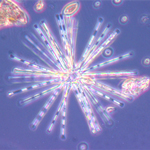PHYLOTOX
 |
Polluo-sensitivity and Phylogeny |
|
Research
Context and Issues
Invertebrates and diatoms have been routinely used as bioindicators for the monitoring of health of aquatic ecosystems. However, the presence of sensitive and tolerant species within these groups raises the question of balancing taxonomic precision and bioindication quality.
In this context, taking phylogenetic relationships into account, as a reflection of species evolutionary history and common ancestry, may help refine assessment of species’ polluo-sensitivity and may have some utility for a priori ecotoxicological risk assessment and a posteriori assessment of water quality (biomonitoring). Furthermore, as evolutionary adaptive processes typically occur at the population level, intraspecific variability in sensitivity also deserves attention, to validate the link between polluo-sensitivity at the species level and phylogeny.
Objectives
The objective of this activity is to improve our understanding of the relationship between response to pollution (organic matter, nutrients, toxic herbicides, insecticides, heavy metals) and phylogeny for a panel of species used for biomonitoring the quality of aquatic environments, in order to explore the utility of integrating phylogeny into biomonitoring approaches. Two compartments are considered as part of this action: diatoms and benthic invertebrates.
Methodology
Two types of databases have been developed:
- Genetic databases: DNA sequences associated with taxon names (INRA databases TCC), NCBI databases), stored on the INRA server Rsyst
- Ecological databases, gathering information on ecological, biological and ecotoxicological traits
Additionally, to address the impact of intraspecific variation in polluo-sensitivity on patterns inferred at broader (phylogenetic) scales, we will focus on selected representative species of two freshwater taxa (crustaceans and gastropods) and on various isolated strains of diatoms. The reaction norm to a set of pollutants will be assessed in the laboratory using genetically differentiated populations or strains of the selected taxa.
Results
The approach developed should determine whether the inclusion of phylogeny provides additional useful information for bioindication, making it more effective and/or faster to implement (development of tools to complement traditional tools). Also, the relative influence of micro-evolutionary processes and phylogenetically inherited tolerance will be compared for a few taxa. The project will generate scientific publications and technical guidelines.People involved
 |
COUTELLEC Marie-Agnès, Scientist Phone : +33 2 23 48 52 48 Email : marie-agnes.coutellec@inrae.fr |
Partners
Funding and Support
ONEMA The French National Agency for Water and Aquatic Environments
